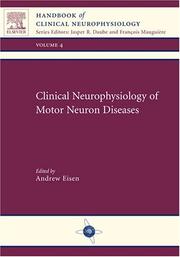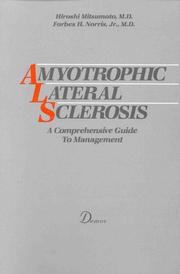| Listing 1 - 10 of 127 | << page >> |
Sort by
|
Book
Year: 2020 Publisher: London, United Kingdom : IntechOpen,
Abstract | Keywords | Export | Availability | Bookmark
 Loading...
Loading...Choose an application
- Reference Manager
- EndNote
- RefWorks (Direct export to RefWorks)
A flurry of recent research on the role of the RNA/DNA-binding proteins TDP-43 and FUS as well as a dozen other factors (e.g., C9ORF72 and profilin) has led to a new paradigm in our understanding of the pathobiology of the motor neuron disease, Amyotrophic Lateral Sclerosis (ALS). How these factors trigger neuromuscular dysfunction is critical for developing more effective ALS therapeutics. The 'gain-of-toxicity' or 'loss-of-function' of these etiological factors is a key question. Recent studies on the imbalance in genome damage versus repair have opened avenues for potential DNA repair-based therapeutics. This book highlights emerging science in the area of ALS and discusses key approaches and mechanisms essential for developing a cure for ALS.
Amyotrophic lateral sclerosis. --- Amyotrophic lateral sclerosis --- Treatment.
Book
Year: 2020 Publisher: London, United Kingdom : IntechOpen,
Abstract | Keywords | Export | Availability | Bookmark
 Loading...
Loading...Choose an application
- Reference Manager
- EndNote
- RefWorks (Direct export to RefWorks)
A flurry of recent research on the role of the RNA/DNA-binding proteins TDP-43 and FUS as well as a dozen other factors (e.g., C9ORF72 and profilin) has led to a new paradigm in our understanding of the pathobiology of the motor neuron disease, Amyotrophic Lateral Sclerosis (ALS). How these factors trigger neuromuscular dysfunction is critical for developing more effective ALS therapeutics. The 'gain-of-toxicity' or 'loss-of-function' of these etiological factors is a key question. Recent studies on the imbalance in genome damage versus repair have opened avenues for potential DNA repair-based therapeutics. This book highlights emerging science in the area of ALS and discusses key approaches and mechanisms essential for developing a cure for ALS.
Amyotrophic lateral sclerosis. --- Amyotrophic lateral sclerosis --- Treatment.
Book
Year: 2020 Publisher: London, United Kingdom : IntechOpen,
Abstract | Keywords | Export | Availability | Bookmark
 Loading...
Loading...Choose an application
- Reference Manager
- EndNote
- RefWorks (Direct export to RefWorks)
A flurry of recent research on the role of the RNA/DNA-binding proteins TDP-43 and FUS as well as a dozen other factors (e.g., C9ORF72 and profilin) has led to a new paradigm in our understanding of the pathobiology of the motor neuron disease, Amyotrophic Lateral Sclerosis (ALS). How these factors trigger neuromuscular dysfunction is critical for developing more effective ALS therapeutics. The 'gain-of-toxicity' or 'loss-of-function' of these etiological factors is a key question. Recent studies on the imbalance in genome damage versus repair have opened avenues for potential DNA repair-based therapeutics. This book highlights emerging science in the area of ALS and discusses key approaches and mechanisms essential for developing a cure for ALS.
Amyotrophic lateral sclerosis. --- Amyotrophic lateral sclerosis --- Treatment.
Book
ISBN: 9782356141286 2356141286 Year: 2018 Publisher: Paris: Empreinte-Temps présent,
Abstract | Keywords | Export | Availability | Bookmark
 Loading...
Loading...Choose an application
- Reference Manager
- EndNote
- RefWorks (Direct export to RefWorks)
Avec ses yeux verts, Francis Valla nous regarde avec intensité, toujours prêt à sourire. Il garde une énergie à déplacer des montagnes, malgré un corps devenu sarcophage. Depuis 2013, il est atteint de la maladie de Charcot qui provoque une paralysie musculaire progressive et inéluctable. Face à cette dévoreuse d'autonomie, il a décidé de vivre envers et contre tout, entouré des siens et porté par sa foi. Semaine après semaine, il nous raconte sa vie et nous fait part de ses réflexions. Aujourd'hui, il ne peut plus parler, mais il communique encore grâce à une tablette. Vivre, avec des doutes et des questions mais porté par un puissant désir d'aimer, de goûter, d'observer, de contempler, de partager la vie et la foi jusqu'au bout ! Ce livre donnera espoir à tous ceux qui traversent des moments de découragement profond dans leur vie. Dieu porte et accompagne chacun, qu'il soit croyant ou qu'il ne le soit pas.

ISBN: 9780444529299 0444529292 9780444513595 Year: 2004 Publisher: Amsterdam ; Boston : Elsevier,
Abstract | Keywords | Export | Availability | Bookmark
 Loading...
Loading...Choose an application
- Reference Manager
- EndNote
- RefWorks (Direct export to RefWorks)
Book
Year: 1984 Publisher: [Taipei] : Shyan-Fu Chou, National Taiwan University,
Abstract | Keywords | Export | Availability | Bookmark
 Loading...
Loading...Choose an application
- Reference Manager
- EndNote
- RefWorks (Direct export to RefWorks)
Book
Year: 2021 Publisher: Australia Exon Publications
Abstract | Keywords | Export | Availability | Bookmark
 Loading...
Loading...Choose an application
- Reference Manager
- EndNote
- RefWorks (Direct export to RefWorks)
Amyotrophic lateral sclerosis is a fatal, progressive neurodegenerative disorder characterized by motor neuron cell death in the brain and spinal cord. The typical disease symptom is the rapid loss of muscle control, which eventually leads to the complete paralysis of voluntary muscles of the entire body. There is no curative treatment for amyotrophic lateral sclerosis. The rarity of the disease and the difficulties in accurate early diagnosis are the major challenges in the proper understanding of the disease and the development of curative therapy. This book brings together a team of experts, both clinicians and basic scientists, to provide a comprehensive understanding of amyotrophic lateral sclerosis, challenges, and approaches to combat this devastating disease. The clinical chapters provide excellent views of diagnosis, pathology, management, and the problem of diagnostic delay. The basic science chapters provide a comprehensive description of pathomechanisms and therapies with emphasis on dysfunctional astrocytes, impaired synaptic transmission, defective axonal transport, biomarkers, cell-based therapies, and gut microbiota. The book is primarily aimed at clinicians and basic scientists; however, it will likely be of interest to a wide audience interested in amyotrophic lateral sclerosis.

ISBN: 0939957582 Year: 1994 Publisher: New York (N.Y.): Demos
Abstract | Keywords | Export | Availability | Bookmark
 Loading...
Loading...Choose an application
- Reference Manager
- EndNote
- RefWorks (Direct export to RefWorks)
Book
Year: 2010 Publisher: Bethesda, MD : National Institutes of Health,
Abstract | Keywords | Export | Availability | Bookmark
 Loading...
Loading...Choose an application
- Reference Manager
- EndNote
- RefWorks (Direct export to RefWorks)
Book
Year: 2021 Publisher: Australia Exon Publications
Abstract | Keywords | Export | Availability | Bookmark
 Loading...
Loading...Choose an application
- Reference Manager
- EndNote
- RefWorks (Direct export to RefWorks)
Amyotrophic lateral sclerosis is a fatal, progressive neurodegenerative disorder characterized by motor neuron cell death in the brain and spinal cord. The typical disease symptom is the rapid loss of muscle control, which eventually leads to the complete paralysis of voluntary muscles of the entire body. There is no curative treatment for amyotrophic lateral sclerosis. The rarity of the disease and the difficulties in accurate early diagnosis are the major challenges in the proper understanding of the disease and the development of curative therapy. This book brings together a team of experts, both clinicians and basic scientists, to provide a comprehensive understanding of amyotrophic lateral sclerosis, challenges, and approaches to combat this devastating disease. The clinical chapters provide excellent views of diagnosis, pathology, management, and the problem of diagnostic delay. The basic science chapters provide a comprehensive description of pathomechanisms and therapies with emphasis on dysfunctional astrocytes, impaired synaptic transmission, defective axonal transport, biomarkers, cell-based therapies, and gut microbiota. The book is primarily aimed at clinicians and basic scientists; however, it will likely be of interest to a wide audience interested in amyotrophic lateral sclerosis.
| Listing 1 - 10 of 127 | << page >> |
Sort by
|

 Search
Search Feedback
Feedback About UniCat
About UniCat  Help
Help News
News